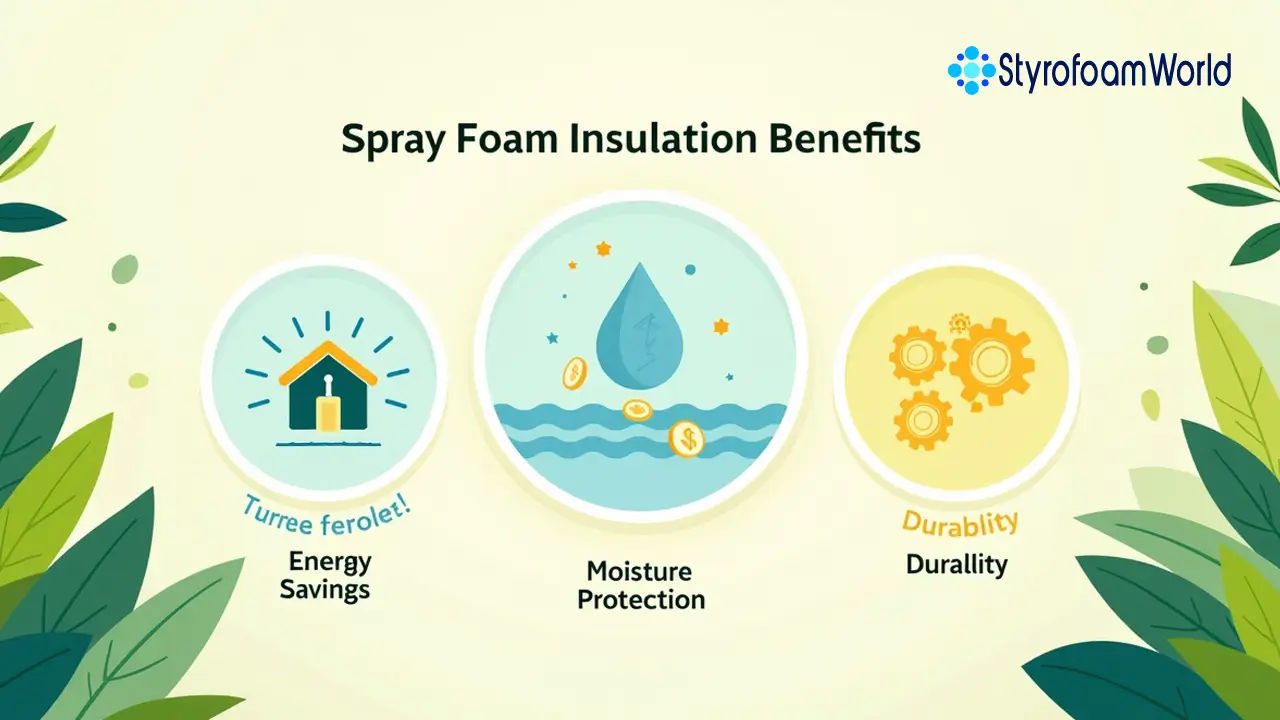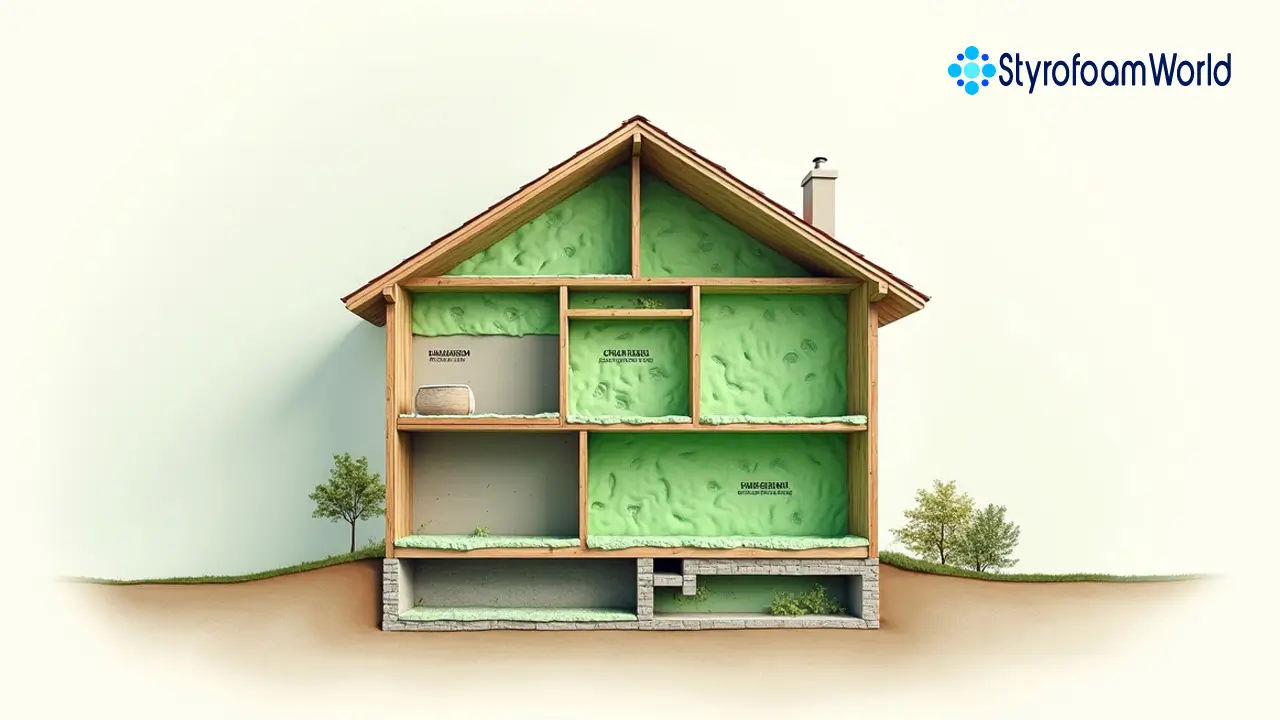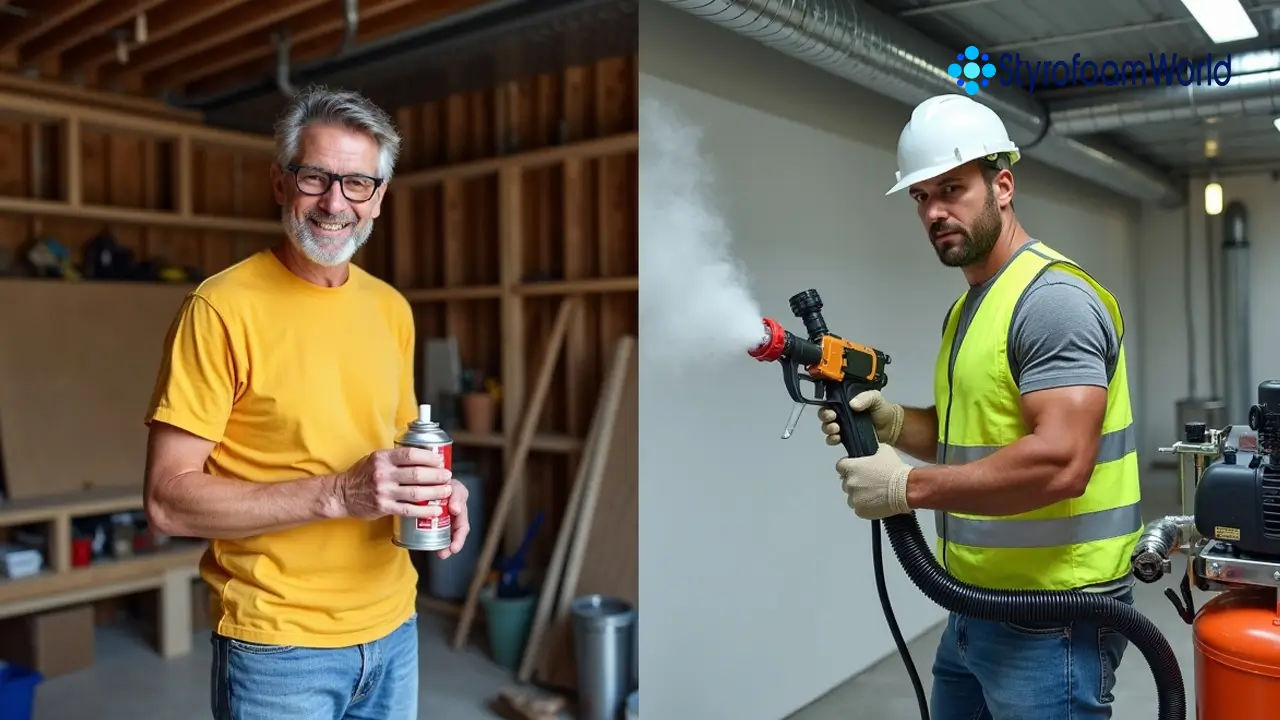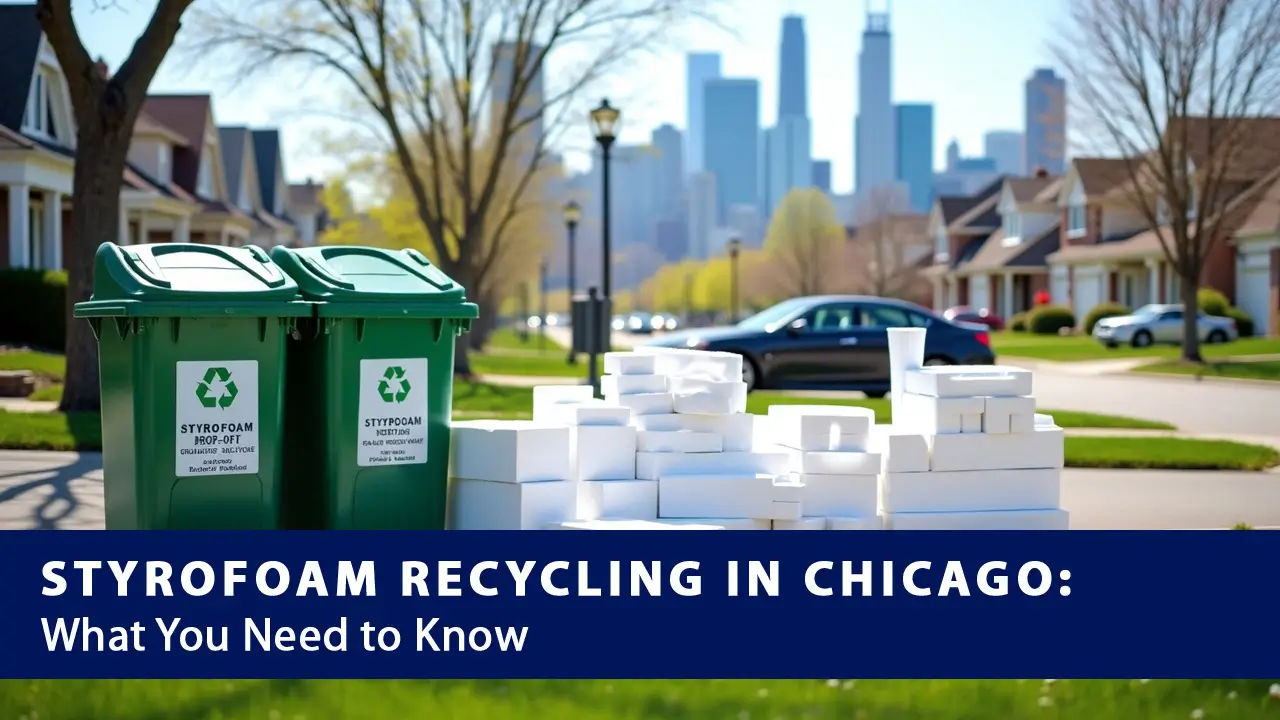How Much Does Spray Foam Insulation Cost in 2025?
Explore pricing per square foot, compare foam types, and find smart ways to save on insulation this year.

© by Styrofoamworld.com
In today's energy-conscious world, homeowners are constantly seeking ways to reduce their energy consumption and lower utility bills. One of the most effective methods to achieve this is through proper home insulation. Among the various insulation options available, spray foam insulation stands out for its superior performance and energy-saving capabilities.
As we approach 2025, it is important for homeowners to understand the costs of spray foam insulation. This knowledge is key for those planning renovations or new buildings. This guide gives clear information about spray foam insulation costs. It will help you make smart choices that fit your budget and energy goals.
2. Understanding Spray Foam Insulation
What is Spray Foam Insulation?
Spray foam insulation is a liquid-applied insulation material that expands upon application, creating a solid, airtight barrier. People know it for sealing gaps and cracks well. It provides thermal insulation and air sealing in one application.
Types: Open-cell vs. Closed-cell
There are two primary types of spray foam insulation:
- Open-cell spray foam: This type is less dense, more flexible, and has a lower R-value per inch. It's ideal for interior applications where moisture resistance is not a primary concern.
- Closed-cell spray foam is denser and more rigid. It has a higher R-value per inch. This foam also acts as a moisture barrier. Because of this, it is good for both indoor and outdoor use.

© by Styrofoamworld.com
3. Benefits of Spray Foam Insulation
Energy Savings
Spray foam insulation provides superior thermal resistance, reducing heat loss in winter and heat gain in summer. This leads to significant energy savings, with homeowners reporting up to 30% reductions in heating and cooling costs.
Moisture Barrier
Closed-cell spray foam is a good moisture barrier. It stops water from getting in and lowers the chance of mold and mildew. This is particularly beneficial in humid climates or areas prone to moisture issues.
Longevity and Durability
Unlike traditional insulation materials, spray foam doesn't sag or settle over time. Its durability ensures consistent performance for decades, often matching the lifespan of the building itself.
4. Factors Influencing Spray Foam Insulation Cost
Material Type
The choice between open-cell and closed-cell foam significantly impacts cost. Closed-cell foam is more expensive due to its higher density and superior insulating properties.
Area Size
Larger areas require more material and labor, increasing the overall cost. However, bulk installations may benefit from economies of scale, potentially reducing the cost per square foot.
Labor and Installation Complexity
Difficult-to-access areas, such as tight crawl spaces or high ceilings, can increase labor costs. Additionally, projects requiring the removal of old insulation or special preparation will incur higher expenses.
5. Average Cost of Spray Foam Insulation in 2025
As of 2025, the average cost of spray foam insulation depends on several factors. Barrier Insulation Inc is one example.
- Homeowners can expect to pay between $1,300 and $4,000 for spray foam insulation. The cost depends on how big and complex the project is. HomeGuide
- Cost per Square Foot: The cost is between $1.00 and $4.50 per square foot. This depends on the type of foam used and how easy it is to access the area. HomeGuide
- Regional Variations: Prices can fluctuate based on local labor rates, climate considerations, and regional building codes. For instance, colder regions may require thicker insulation layers, increasing material costs.
6. Cost Comparison: Open-cell vs. Closed-cell
When choosing between open-cell and closed-cell spray foam insulation, cost is very important. This is especially true for homeowners on a budget. While both offer strong thermal insulation, the price difference can significantly affect your project's total cost.
Open-cell Spray Foam:
- Cost per sq ft: $0.90 to $1.50
- Best for: Interior walls, attics, and soundproofing
- R-value: About 3.5 per inch
Open-cell foam is cheaper and expands more, making it ideal for filling irregular spaces. It also provides excellent sound dampening but is less moisture-resistant.
Closed-cell Spray Foam:
- Cost per sq ft: $1.75 to $4.50
- Best for: Basements, exterior walls, crawl spaces
- R-value: About 6 to 7 per inch
Closed-cell foam is more expensive but offers higher R-values and serves as a moisture and vapor barrier, increasing its long-term value. For homeowners in damp climates or with basements prone to moisture, this may be the more cost-effective solution in the long run.

© by Styrofoamworld.com
7. Spray Foam Insulation Cost by Area
The cost of spray foam insulation varies based on the area you treat. Here’s a breakdown by common home areas:
Attic:
- Average cost: $1,500 – $4,500
- Cost per sq ft: $1.50 – $3.00
Attics are among the most insulated parts of the house due to their role in regulating indoor temperatures. Closed-cell foam is often used here to prevent heat loss and moisture build-up.
Walls:
- Average cost: $1,000 – $3,000
- Cost per sq ft: $1.00 – $2.80
Wall insulation depends on whether you're insulating new construction or retrofitting. Existing walls may require more prep work, increasing labor costs.
Basement:
- Average cost: $1,300 – $3,800
- Best choice: Closed-cell foam for moisture control
Basements benefit from closed-cell foam because of its moisture barrier properties. Proper insulation here can also prevent pipe freezing in winter.
Crawl Spaces:
- Average cost: $800 – $2,500
- Challenges: Tight space may increase labor costs
Insulating crawl spaces helps save energy. It reduces heat loss through the floor. This is especially important in older homes with wooden floors.

© by Styrofoamworld.com
8. DIY vs. Professional Installation
Some eco-conscious homeowners consider DIY installation to cut costs. While kits are available, the process isn't as simple as it seems.
DIY Kits:
- Cost: $300 – $800 for 200 sq ft
- Includes: Hoses, nozzles, and foam tanks
- Best for: Small projects and experienced DIYers
DIY spray foam kits can look inexpensive. However, they often lack the professional appearance and safety features that come with licensed installers. Additionally, incorrect application can lead to air leaks or foam shrinkage, reducing energy efficiency.
Professional Installation:
- Advantages: Quality control, safety compliance, long-term performance
- Warranty: Most contractors offer 10+ year warranties
Professionals ensure the job is done right the first time, minimizing long-term issues. If you need to insulate a big area, hiring a certified contractor is a good idea. This is especially true if you want high R-value coverage.
9. Spray Foam Insulation Cost Calculators
Before beginning your insulation project, use online calculators to get a reliable cost estimate. These tools help you gauge your budget based on dimensions and desired foam type.
Popular Tools Include:
These calculators ask for inputs like room dimensions, foam type, and regional location. Some also allow you to factor in labor, old insulation removal, and additional sealing work.
Using a calculator early in your planning helps avoid surprises. It also lets you compare contractor estimates with realistic expectations.
10. Tips to Save on Spray Foam Insulation
Spray foam insulation might seem expensive at first. However, with the right tips, you can lower costs and still save energy.
Top Money-Saving Tips:
- Time it right: Schedule installation during off-peak seasons (late spring or early fall) when demand is lower.
- Government rebates: Check for state and federal energy efficiency incentives. The U.S. Department of Energy and Energy Star programs often offer rebates.
- Get multiple quotes: Always compare at least 3 local contractors to find competitive pricing.
- Combine projects: If you're already renovating or replacing HVAC systems, bundle spray foam installation to save on labor costs.
- Utility company programs: Some power providers offer discounts or financing plans for energy-efficient home upgrades.
These savings strategies make high-performance insulation easier to get. This is great for eco-friendly families who want to lower their carbon footprint.
11. Environmental Impact and Sustainability
For homeowners passionate about sustainability and eco-conscious living, spray foam insulation presents both benefits and concerns. Understanding its environmental impact can help make more informed choices.
Eco-friendly Advantages:
- Spray foam creates a tight seal. This helps reduce energy use and lowers your carbon footprint.
- Longevity cuts down on waste. Spray foam lasts longer than other insulation types. This means less waste in landfills over time.
Concerns to Consider:
- Petrochemical base: Spray foam is made from polyurethane, which comes from petroleum — a non-renewable resource.
- Emissions during production: Making spray foam releases greenhouse gases. This is especially true for closed-cell types that use blowing agents with high global warming potential (GWP).
Sustainable Choices:
- Opt for low-GWP spray foams that use water-based or non-HFC blowing agents.
- Work with certified “green” contractors who prioritize sustainable practices.
Spray foam can help make a home more sustainable. It works well with solar panels, efficient HVAC systems, and good recycling practices. This combination can lower the overall impact on the environment.
12. Common Mistakes to Avoid
Investing in spray foam insulation is a major decision, and avoiding common pitfalls ensures the best results. Many homeowners unknowingly make mistakes that cost them time, money, and comfort.
Top Mistakes to Avoid:
- Using the wrong type of foam can cause issues. Open-cell foam is not good for damp areas. If you use it in basements or crawl spaces, it can lead to moisture problems.
- Inadequate surface prep: Dirty or moist surfaces reduce adhesion and efficiency. Surfaces should be clean and dry before application.
- Skipping ventilation: Sealing your home completely without addressing ventilation can trap humidity and toxins inside.
- DIY errors: Uneven spraying, insufficient coverage, and improper mix ratios often occur when amateurs handle the job.
Working with skilled contractors, asking good questions, and knowing your home’s needs can help avoid mistakes. This will ensure a successful insulation upgrade.
13. Financing and Incentives
Spray foam insulation can be a big upfront cost. However, homeowners do not have to pay the full amount by themselves. Several financing options and government incentives can lighten the financial load.
Financing Options:
- Home improvement loans: Available through banks or credit unions, often with competitive interest rates.
- Contractor payment plans: Some contractors offer in-house financing with low or zero interest for a set period.
- Home equity lines of credit (HELOC) are great for big projects. They let you use lower interest funds based on your home's value.
Incentives and Tax Credits:
- - Homeowners can receive a federal tax credit.
- - This is part of the Inflation Reduction Act.
- - They can get back 30% of their insulation costs.
- State programs: California, New York, and other eco-friendly states offer rebates through utility companies or energy offices.
- Energy Star rebates: Products meeting ENERGY STAR standards often qualify for cash rebates or energy discounts.
These programs make it easier for environmentally conscious families to invest in high-efficiency solutions without breaking the bank.
14. Choosing the Right Contractor
Your spray foam insulation project is only as good as the contractor you hire. Choosing an experienced, certified installer ensures long-lasting results and a better return on investment.
Key Factors to Look For:
- Certification: Look for contractors certified by the Spray Polyurethane Foam Alliance (SPFA).
- Insurance: Ensure they are licensed and fully insured to protect your home during installation.
- References and reviews: Check reviews on platforms like Yelp, Google, or Angie’s List and ask for client references.
Questions to Ask Before Hiring:
- How long have you been installing spray foam insulation?
- Can you show me past projects or client testimonials?
- What type of spray foam do you use and why?
- Do you provide warranties or maintenance plans?
A trustworthy contractor will answer all your questions transparently and provide a detailed estimate — not just a rough quote. Take the time to vet professionals properly to ensure peace of mind and a job well done.
15. Conclusion
Spray foam insulation is not just a trend. It is a smart investment for your home. It improves efficiency, comfort, and reduces your environmental impact.
The initial cost may seem high, but the long-term benefits are worth it. You can save on energy bills, improve moisture control, and increase your home's value.
If you want to insulate your attic, walls, basement, or crawl spaces, knowing the costs of spray foam insulation is important. This knowledge will help you make a smart, budget-friendly, and eco-friendly choice.
Remember to compare open-cell and closed-cell options. Use online cost calculators. Take advantage of rebates and financing programs to get the best value.
If you care about the environment, spray foam can help you lower your carbon footprint. It also makes your home healthier and more energy-efficient. Don’t wait — explore your options today and start saving tomorrow.
FAQs
1. How much does spray foam insulation cost per square foot in 2025?
In 2025, spray foam insulation costs between $1.00 and $4.50 per square foot, depending on foam type, labor, and location.
2. Is spray foam worth the higher cost compared to fiberglass?
Yes, spray foam costs more at first. However, its airtight seal, higher R-value, and moisture resistance make it a better choice over time.
3. Can I install spray foam insulation myself?
You can, using DIY kits, but it's only recommended for small projects. For full-home insulation, professional installation ensures better results and fewer issues.
4. Are there any rebates available for spray foam insulation?
Yes! Many federal and state programs provide rebates, tax credits, or energy incentives. This is especially true for ENERGY STAR and local utility providers.
5. What areas of my home benefit most from spray foam insulation?
Attics, crawl spaces, basements, and exterior walls are ideal for spray foam. These areas see the greatest energy efficiency improvements and moisture control benefits.



